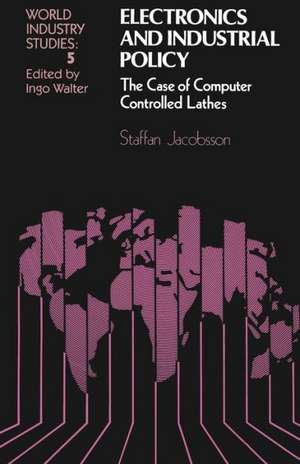Electronics and Industrial Policy: The case of computer controlled lathes: World Industry Studies, cartea 5
Autor Staffan Jacobssonen Limba Engleză Paperback – 14 mai 2012
Preț: 384.09 lei
Nou
Puncte Express: 576
Preț estimativ în valută:
73.51€ • 75.93$ • 61.17£
73.51€ • 75.93$ • 61.17£
Carte tipărită la comandă
Livrare economică 25 martie-08 aprilie
Preluare comenzi: 021 569.72.76
Specificații
ISBN-13: 9789401164887
ISBN-10: 9401164886
Pagini: 276
Ilustrații: XX, 252 p.
Dimensiuni: 140 x 216 x 14 mm
Greutate: 0.32 kg
Ediția:Softcover reprint of the original 1st ed. 1986
Editura: SPRINGER NETHERLANDS
Colecția Springer
Seria World Industry Studies
Locul publicării:Dordrecht, Netherlands
ISBN-10: 9401164886
Pagini: 276
Ilustrații: XX, 252 p.
Dimensiuni: 140 x 216 x 14 mm
Greutate: 0.32 kg
Ediția:Softcover reprint of the original 1st ed. 1986
Editura: SPRINGER NETHERLANDS
Colecția Springer
Seria World Industry Studies
Locul publicării:Dordrecht, Netherlands
Public țintă
ResearchCuprins
1 Introduction.- 2 The Technology and its Diffusion.- 2.1 Introduction.- 2.2 CNC lathe technology.- 2.3 Choice of technique in turning.- 2.4 The factor-saving bias of CNC lathes.- 2.5 Conclusions.- 3 Growth and Market Structure in the International CNC Lathe Industry.- 3.1 Introduction.- 3.2 A theoretical framework for analysing the industry.- 3.3 The Japanese expansion in the CNC lathe industry.- 3.4 The European response.- 3.5 A note on the US producers.- 3.6 Concluding remarks on the strategies pursued by firms based in the OECD.- Notes.- 4 Barriers to entry into the Overall Cost Leadership Strategy.- 4.1 Research and Development.- 4.2 Procurement of components.- 4.3 Manufacturing.- 4.4 Marketing and after-sales services.- 4.5 An attempt to specify the minimum efficient scale of production.- Notes.- 5 The position of the NICs within the CNC Lathe Industry.- 5.1 The position of eight NIC-based firms within the low-performance strategy.- Notes.- 6 The Case of Argentina.- 6.1 Growth and structure of the engineering industry.- 6.2 The Argentinian machine tool industry.- 6.3 Government policy.- 6.4 The diffusion of CNC lathes in Argentina.- 6.5 The firm producing CNC lathes.- 6.6 Summary and conclusions.- Notes.- 7 The Case of Taiwan.- 7.1 Growth and structure of the engineering industry.- 7.2 The Taiwanese machine tool industry.- 7.3 Government policy.- 7.4 The diffusion of CNC lathes in Taiwan.- 7.5 The firms producing CNC lathes.- 7.6 Government policy in the machine tool field.- 7.7 Evaluating the explicit governmental policy.- 7.8 Summary and conclusions.- Note.- 8 The Case of Korea.- 8.1 Growth and structure of the engineering industry.- 8.2 The Korean machine tool industry.- 8.3 Government policy.- 8.4 The Korean market for CNC lathes.- 8.5 The firms producing CNClathes.- 8.6 Evaluating governmental policy.- 8.7 Summary and conclusions.- Notes.- 9 Government Policy.- 9.1 Introduction.- 9.2 Survey of the main arguments.- 9.3 Government policy and industry performance in Argentina, Korea and Taiwan.- 9.4 Industry performance and implications for government policy in small developed countries.- 9.5 Conclusions.- Notes.- 10 Summary.- 10.1 The diffusion of CNC lathes.- 10.2 The international CNC lathe producing industry.- 10.3 The NIC experience.- 10.4 Government policies.- References.












